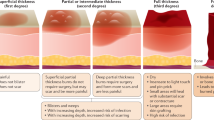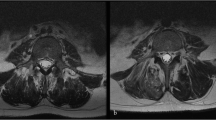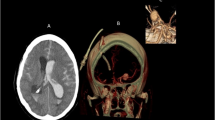Abstract
The objective of this study was to report on a 34-year-old woman who presented with tethered cord syndrome due to dermal sinüs tract. A 34-year-old woman had got dermal sınüs tract admitted to our hospital with swelling on the neck, pain and numbness on the left upper limb. She was treated by surgical removal of dermal sinuses and untethering the spinal cord which is stretched by the dermal sinus. Congenital dermal sinus tracts are uncommon types of cranial and spinal dysraphisms. They can occur in the midline of the craniospinal axis from the occiput to the sacral region. For dermal sinuses, cervical region is very rare location that is reported in the literature. They are diagnosed usually in childhood with skin signs, neurological deficits, local infections and meningitis. We present a rare case of dermal sinus tract located in cervical region. Early diagnosis and treatment of cervical dermal sinus tract are important to prevent neurological deficits.
Similar content being viewed by others
Introduction
Dermal sinuses are congenital malformation, which are the subtype of occult spinal dysraphism.1 They are result from incomplete separation of epithelial and neural ectoderm. Failed disjunction causes persistent tract line between the skin and deeper tissues.2 Most of cases are located at the lumbosacral region. Dermal sinus tracts may enter the subarachnoid space or reach into the subdural space. Twenty-seven percent of the cases attach the neural tissue.3 The patients commonly have no neurological deficit. However, neurological disorders can be seen because of cord compression secondary to infectious proces or tethered cord syndrome.4 In this report, we described a case of dermal sinuses that is uncommon location and associated with another occult spinal dysraphisms.
Case presentetation
A 34-year-old woman admitted to our clinic with swelling on the neck, pain and numbness on the left upper limb and fatigue. Physical examination showed a pinhole opening at the C5-6 level. Neurological examination revealed hypoesthesia on the left upper limb at the C6-7 dermatome. There was no motor deficit. Laboratory evaluations were normal. Cervical magnetic resonance imaging showed multiple occult spinal dysraphism at the level of C5-6-7 (Figure 1). She underwent surgical treatment. C5-6 total and C4 partial laminectomy were performed. There was a dermal sinus that reach into the subdural space and attach the spinal cord. Dermal sinus was excised and untethering was achieved by dissecting the fibrous band. The spinal cord was divided by the fibrous band and there was syrinx in the spinal cord. Syrinx drainage was performed. The fibrous band between the two hemicord was resected and dura closed primarily and then myocutaneous layers closed. The patient was free of her symptoms 3 months after the operation and spinal cervical MR evaluation showed normal imaging (Figure 2).
Discussion
Dermal sinus tract was first described by Ogle in 1865. The incidence of dermal sinuses is approximately 1:2500 live birth.5 There are many clinicial manifestations such as neurological disorders, orthopedic signs, cutaneous findings and urological symptoms. Cutaneous signs is the most common reason for refer to hospital in young patients.4 Most of patient presents in childhood and only 4% of patient presents after the age of 20 as reported by French in 1990.6 Our patient was asymptomatic until 34 years old. Dermal sinuses are associated with other occult spinal dysraphism in the rate of 40 and 10% of patients who have occult spinal dysraphism have congenital dermal sinuses.7 Tethered cord, bifid lamina, split cord malformation, inclusion tumors such as epidermoid and dermoid cysts, tight filum terminalis and myelomeningocele can be seen together with dermal sinus tracts.4 In this reported case, dermal sinus was associated with split cord malformation and tethered cord. The best radiodiagnostic modality for dermal sinuses is magnetic resonance imaging. Magnetic resonance imaging gives us information about the neural structures and other related anomalies. This is important for surgery planning.8 The first aim of surgery is total excision of the dermal sinus. Surgeons usually need to open the dura for complete resection of the dermal sinus and other intradural lesions.9 In this case we opened the dura for total removal of the dermal sinus tract and untethering the cord. Surgery is performed for acute neurological deficits due to infectious events, symptomatic tethered cord or prophylactic in children. Dermal sinus associated with tethered cord should be treated surgically as soon as possible before occurence of neurological deterioration.7
Conclusion
Dermal sinuses are type of occult spinal dysraphism. They are often seen in the lumbosacral region. They can be seen in the cervical region rarely. Tethered cord and other occult spinal dysraphism may be accompanied dermal sinuses.
References
Ackerman LL, Menezes AH, Follett KA . Cervical and thoracic dermal sinus tracts. A case series and review of the literature. Pediatr Neurosurg 2002; 3: 137–147.
French BN . The embryology of spinal dysraphism. Clin Neurosurg 1983; 30: 295–340.
Muraszko KM . Spinal dysraphism in adult and pediatric population. In: Grossman RG, Loftus CM (eds). Principles of Neurosurgery. 2nd ed, Lippincott-Raven: Philadelphia, PA, 1999, pp 59–76.
Ackerman LL, Menezes AH . Spinal congenital dermal sinuses: a 30-year experience. Pediatrics 3 Pt 2003; 1: 641–647.
McIntosh R, Merritt KK, Richards MR, Samuels MH, Bellows MT . The incidence of congenital malformations: a study of 5964 pregnancies. Pediatrics 1954; 14: 505–522.
French BN . Midline fusion defects and defects of formation. In: Youmans J (ed.) Neurological surgery. Saunders Company: Philadelphia, 1990, pp 1081–1235.
Roth S, Beni-Adani L, Xiao B, Sira LB, Constantini S . Spinal Dermal Sinuses. In: Özek MM, Cinalli G, Maixner WJ (eds). The Spina Bifida Management and Outcome. Springer-Verlog: Milan, 2008, pp 515–525.
Lode HM, Deeg KH, Krauss J . Spinal sonography in infants with cutaneous birth markers in the lumbo-sacral region-an important sign of occult spinal dysrhaphism and tethered cord. Ultraschall Med 2008; 29: 281–288.
Elton S, Oakes WJ . Dermal sinus tracts of the spine. Neurosurg Focus 2001; 10: e4.
Author information
Authors and Affiliations
Corresponding author
Ethics declarations
Competing interests
The authors declare no conflict of interest.
Rights and permissions
About this article
Cite this article
Karatas, Y., Ustun, M. Congenital cervical dermal sinus tract caused tethered cord syndrome in an adult: a case report. Spinal Cord Ser Cases 1, 15021 (2015). https://doi.org/10.1038/scsandc.2015.21
Received:
Revised:
Accepted:
Published:
DOI: https://doi.org/10.1038/scsandc.2015.21
This article is cited by
-
Posterior cervical congenital dermal sinus tract: case report and review of literature
Spinal Cord Series and Cases (2023)
-
Double dermal sinus tracts of the cervical and thoracic regions: a case in a 3-year-old child and review of the literature
Child's Nervous System (2018)





